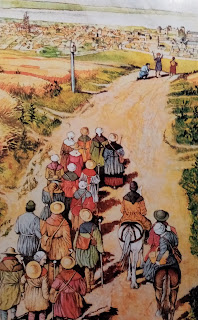Pilgrims

Pilgrimage With more than its share of patron saints, Scotland was a magnet for pilgrims from abroad. Scots also took to the holy routes, which were often long, arduous, and dangerous. Pilgrimage and the cults of saints were as popular with the Pictish, Irish, Norse and Scots peoples of Scotland as with any others in Christendom. With major shrines at the heart of important reliquary churches at Iona, St Andrews, Kirkwall, Whithorn, Glasgow, Dunkeld, Dunfermline and Tain, Scotland had more than its fair share of patron saints, ranging from Andrew – an apostle of Christ - through national, indigenous saints such as Ninian, Columba and Kentigern, to a multiplicity of lesser holy men and martyrs. From the earliest times, Scots were recognised on the pilgrimage of the early missionaries were elected saints, with some, such as Columba of lona, who died in 597, regarded as saints even during their own lifetime. These places of burial became renowned. Possibly the oldest shri...